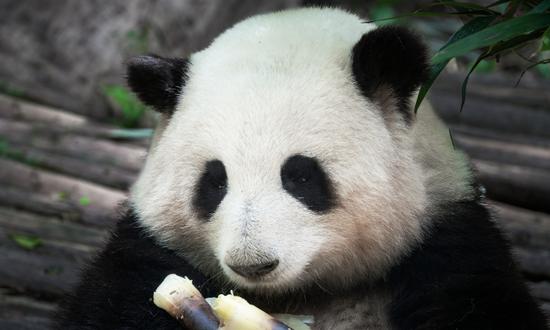National darling Hua Hua boosts China's 'giant panda economy'
The giant panda Hua Hua attracted 264,000 visitors to the Chengdu Research Base of Giant Panda Breeding, which was the second most popular tourist destination in China during the May Day holidays, according to local media reports.
The "giant panda economy" has become a bright spot in the country's consumption, with numerous cultural and creative shops in Chengdu and across the country filled with a wide variety of panda-related products.
He Hua (nicknamed Hua Hua) will soon be three years old and has captivated the hearts of Chinese people thanks to her mild temperament and her rare inability to climb trees. She is also different from other giant pandas because of her white fur, rather than the more common beige color, and her chubbiness, making her highly recognizable.
He Hua's family background further boosts her appeal, as her mother is Chenggong, known for her obsession with cleanliness, and her father is Meilan, who was born in the US.
Many young people travel to Southwest China's Sichuan Province just to see the giant pandas. Celebrity giant panda Hua Hua boosted ticket sales at the Chengdu Research Base of Giant Panda Breeding, with all 180,000 tickets selling out for the first three days of this year's May Day holidays. There were so many visitors that the park had to set Hua Hua's viewing time limit to only three minutes.
"We made this special trip to come here to see Hua Hua," said a tourist. "We plan to stay at the base all day just to see the giant pandas and we plan to continue coming here even tomorrow," he added.
On the social media platform Xiaohongshu, a netizen posted a photo of Hua Hua eating an apple and wrote "Hua Hua and her favorite little apple," which quickly garnered more than 2,500 likes.
China is in the grip of giant panda fever following a spate of stories about the bears both at home and in overseas zoos, which has sparked a shopping spree for products related to the animal. The sales have prompted the media to dub it the "giant panda economy."
The Chengdu Research Base of Giant Panda Breeding rushed to register several trademarks after He Hua became a national darling and a key search word on e-commerce websites. The trademarks are related to fields including clothing, shoes, hats, feed seeds, education and entertainment.
The last giant panda to cause a rush was the mascot for the Beijing 2022 Winter Olympic Games, Bing Dwen Dwen, which was created based on the image of a giant panda. More than 1.4 million toy mascots were sold during the Games, according to media reports.
Earlier this year, it emerged that Ya Ya's health was failing, sparking national concern in China and demands for her early return. Ya Ya, a giant panda born at Beijing Zoo, was leased to Memphis Zoo in 2003. At the end of last year, it was announced that she would be returned to China at the end of the 20-year lease.
In addition to Ya Ya, several other giant pandas living overseas have been returned to China this year, including Xiang Xiang, who returned to China in February from the Ueno Zoo in Tokyo in Japan.
Along with Hua Hua, Ya Ya and Xiang Xiang, Meng Lan is also one of the most popular giant pandas across the country. On the first day of the May Day holidays, thousands of people lined up outside the giant panda house at Beijing Zoo, waiting half an hour to get in just to see Meng Lan for five minutes.
Behind the "giant panda craze" is the continuous growth of the population of this species amid China's green development. At present, the wild population of giant pandas in China has increased from 1,114 in the 1970s to 1,864. With the advancement of the construction of the Giant Panda National Park, the connectivity and integrity of the giant panda habitat are being improved.

